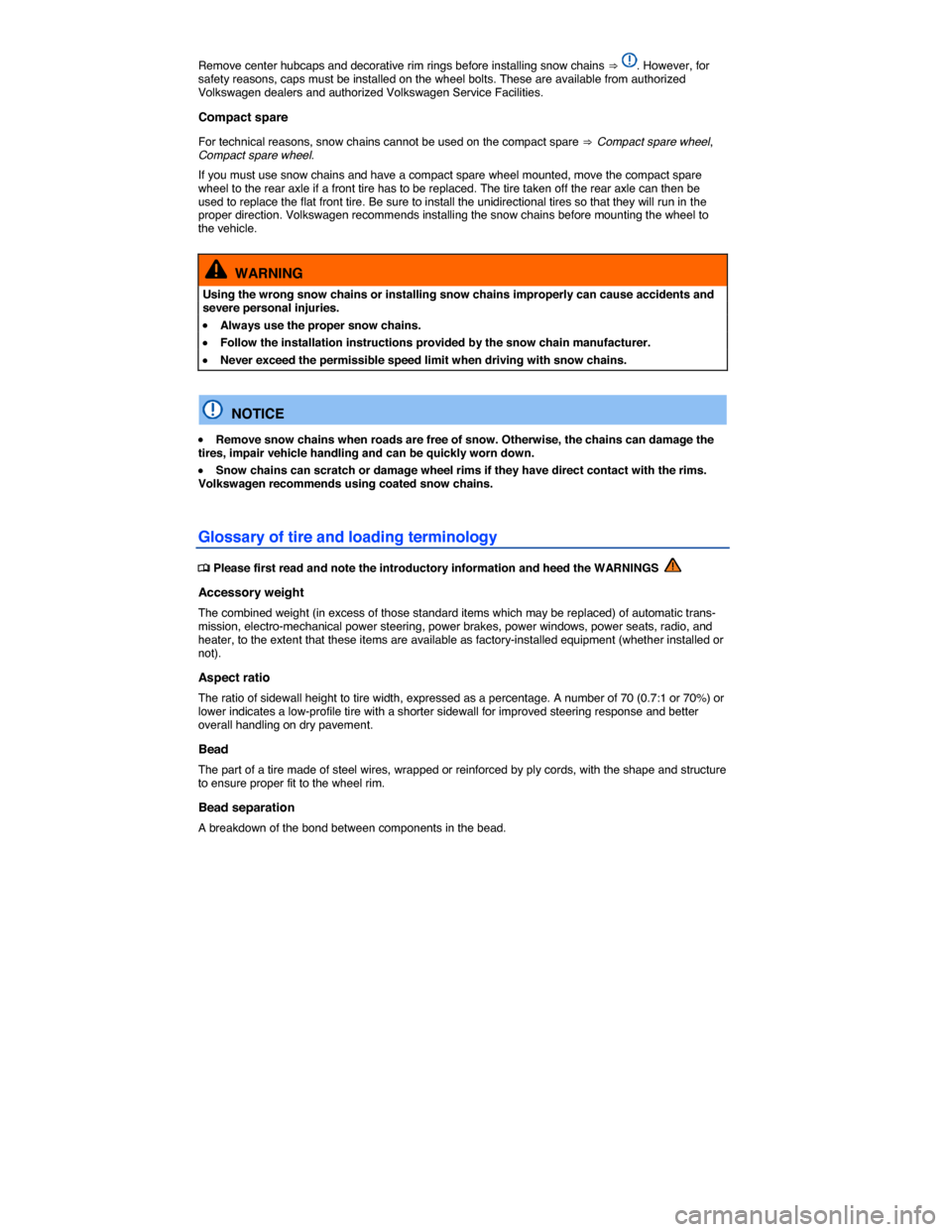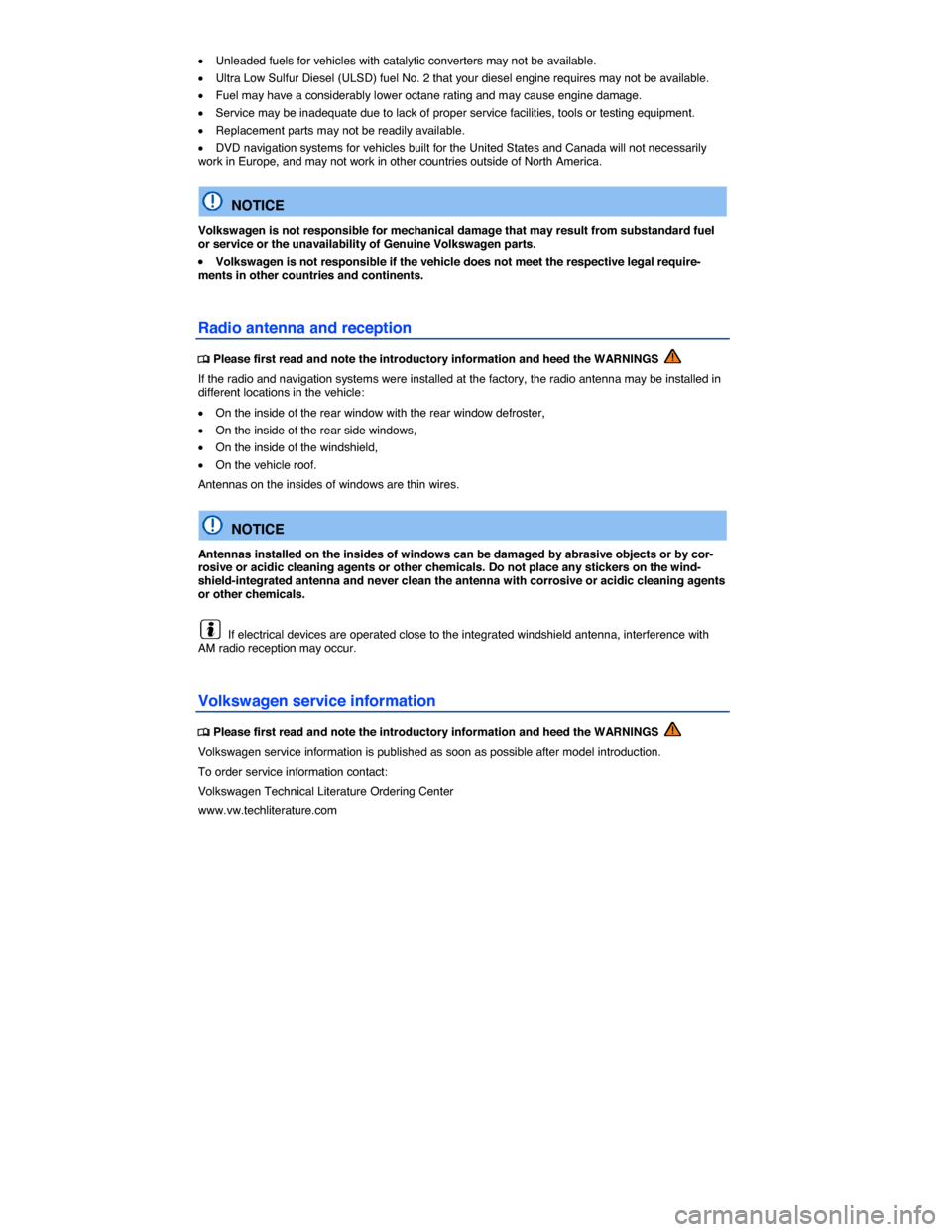2015 VOLKSWAGEN PASSAT Ties
[x] Cancel search: TiesPage 33 of 397

Safe & Secure:
Feature Description
Automatic Crash Notification (ACN)
Automatic Crash Notification is initiated in the event of airbag deployment or rollover. When the feature is activated the Volkswagen Car-Net Response Center is notified of your location and contacts your vehicle to determine the risk of injury and to dispatch help. Help is dispatched even if the Volkswagen Car-Net Response Center does not connect to the vehicle's occupants. Auto-matic Crash Notification may be engaged for up to 6 months without activating a trial or paid subscription.
Manual Emergency Call
In the case of an emergency, press the • button in the 3-button module: The Volkswagen Car-Net device initiates a connection to the Volkswagen Car-Net Response Center. The location of the vehicle and customer data for identifica-tion is sent at the same time.
Roadside Assis-tance
Press the �> button in the 3-button module: The vehicle will connect directly to the Volkswagen Roadside Assistance Call Center. The vehicle’s location is also transmitted in order to more quickly provide assistance.
Stolen Vehicle Location Assis-tance For use by law enforcement au-thorities only. See Terms of Service at www.vw.com/carnet for details.
After you have reported your vehicle as stolen to law enforcement, you may provide the case information to the Volkswagen Car-Net Response Center. Once the information has been verified, the VW Car-Net Customer Specialist will be able to provide law enforcement with vehicle location data sent by the VW Car-Net module.
Family Guardian:
Feature Description
Boundary Alert
By logging on to your Volkswagen Car-Net account, you can designate an area on a map as a “virtual fence.” The vehicle owner can then choose notification channels (text message or email) for receiving alerts when the vehicle crosses the defined boundary (texts and data rates apply).
Speed Alert
Volkswagen Car-Net can be configured to inform the vehicle owner whenever the vehicle exceeds a speed set by the owner. The owner can select to be informed through multiple channels, including text messages and email (text and data rates apply).
Remote Vehicle Access:
Feature Description
Page 47 of 397

Remote start feature
Press the button (3) to activate the remote start feature ⇒ Starting and stopping the engine.
Replacement vehicle keys
The vehicle identification number is required to get a replacement key or an additional remote control vehicle key.
Up to 8 vehicle keys, each of which must be properly cut, coded, programmed, and synchronized, can be used with your vehicle.
Each new vehicle key contains a microchip and must be coded with the data from the vehicle's elec-tronic immobilizer. A vehicle key will not work if it does not contain a microchip or contains a chip that is not coded, even if the key bit was cut correctly.
You can obtain additional or duplicate remote control vehicle keys from authorized Volkswagen deal-ers, authorized Volkswagen Service Facilities, and from certain independent repair facilities and lock-smiths which are qualified to make remote control vehicle keys.
Each vehicle key must be programmed by an authorized Volkswagen dealer, an authorized Volkswagen Service Facility in order for it to work with your vehicle.
To find the nearest qualified independent repair facility, locksmith, or Volkswagen dealer which can cut and code replacement vehicle keys, call the VW Customer Care Hotline at 1-800-822-8987 or visit http://www.vw.com and search for “replacement keys.”
Canadian customers can contact an authorized Volkswagen dealer or Volkswagen Service Facility or call the Volkswagen Canada Customer CARE Center at (1-800-822-8987).
NOTICE
The remote control vehicle keys contain electrical components. Protect them from damage, moisture and rough handling.
Do not press the buttons on the remote control vehicle key unless you actually want to use the function in question. Since terrain and conditions vary, pressing a button on the remote control vehicle key when it is not necessary may unlock the vehicle or set off the panic alarm, even if you think you are out of range.
Remote control vehicle key functions can be temporarily disrupted by interference from transmit-ters near the vehicle that use the same frequency range (such as radio equipment or mobile phones).
Things between the remote control vehicle key and vehicle, bad weather, as well as a weak battery can reduce the operating range.
If the remote control vehicle key buttons ⇒ Vehicle key set or the power locking buttons ⇒ Un-locking and locking the vehicle from the inside are pushed repeatedly in quick succession, the power locking system is switched off for a brief period to help keep it from being overloaded. The vehicle is then unlocked for about 30 seconds. Unless a door or the luggage compartment lid is opened in this span of time, the vehicle is automatically locked afterwards.
Page 82 of 397

Certain batteries used in hand-held remote controls are classified as Perchlorate Material. Special handling may apply – see http://www.dtsc.ca.gov/hazardouswaste/perchlorate. Obey all legal requirements regarding proper disposal. Authorized Volkswagen dealers and authorized Volkswagen Service Facilities are familiar with the requirements, and we recommend that you have them perform this service for you.
Page 115 of 397

WARNING
Improper handling, care, servicing, and repair procedures can increase the risk of personal injury and death by preventing a belt pretensioner from activating when needed or by caus-ing it to activate unexpectedly.
�x The pretensioner can be activated only once. If a pretensioner has been activated, the safety belt must be replaced.
�x Safety belt systems including the pretensioners cannot be repaired. Special procedures are required to remove, install, and dispose of this system.
�x Never repair, adjust, or change pretensioners or any other part of the safety belt system yourself. We strongly recommend that you have any work on the safety belt system per-formed by an authorized Volkswagen dealer or authorized Volkswagen Service Facility. They
have the necessary technical information, training, and special equipment ⇒ Parts, accesso-ries, repairs and modifications.
WARNING
Undeployed safety belt pretensioners and airbag modules contain explosive materials that can cause serious personal injuries if they are not properly handled when they or the vehi-cles they are installed in are scrapped.
�x Never abandon vehicles or vehicle parts.
�x Always scrap vehicles and vehicle parts, especially those containing undeployed airbag modules and undeployed safety belt pretensioners, at a licensed facility that has the knowledge and experience to properly dispose of the vehicle and its safety belt and airbag systems.
Undeployed airbag modules and safety belt pretensioners are classified as Perchlorate Materi-al. Special handling may apply – see http://www.dtsc.ca.gov/hazardouswaste/perchlorate. Obey all applicable legal requirements regarding handling and disposal of the vehicle or parts of its restraint system, including airbag modules and safety belts with pretensioners. Authorized Volkswagen dealers and authorized Volkswagen Service Facilities are familiar with the requirements, and we recommend that you have them perform this service for you.
Page 179 of 397

Remove center hubcaps and decorative rim rings before installing snow chains ⇒ . However, for safety reasons, caps must be installed on the wheel bolts. These are available from authorized Volkswagen dealers and authorized Volkswagen Service Facilities.
Compact spare
For technical reasons, snow chains cannot be used on the compact spare ⇒ Compact spare wheel, Compact spare wheel.
If you must use snow chains and have a compact spare wheel mounted, move the compact spare wheel to the rear axle if a front tire has to be replaced. The tire taken off the rear axle can then be used to replace the flat front tire. Be sure to install the unidirectional tires so that they will run in the proper direction. Volkswagen recommends installing the snow chains before mounting the wheel to the vehicle.
WARNING
Using the wrong snow chains or installing snow chains improperly can cause accidents and severe personal injuries.
�x Always use the proper snow chains.
�x Follow the installation instructions provided by the snow chain manufacturer.
�x Never exceed the permissible speed limit when driving with snow chains.
NOTICE
�x Remove snow chains when roads are free of snow. Otherwise, the chains can damage the tires, impair vehicle handling and can be quickly worn down.
�x Snow chains can scratch or damage wheel rims if they have direct contact with the rims. Volkswagen recommends using coated snow chains.
Glossary of tire and loading terminology
�
Page 183 of 397

U.S. DOT Tire Identification Number (TIN)
A tire's serial number. It begins with the letters “DOT” (“Department of Transportation”) and indicates that the tire meets all federal standards. The next two numbers or letters indicate the plant where the tire was manufactured. The last four numbers represent the week and year of manufacture.
For example, the numbers 1709 mean that the tire was produced in the 17th week of 2009. Any other numbers are marketing codes used by the tire manufacturer. This information is used to help identify affected consumers if a tire defect requires a recall.
Vehicle capacity weight
The total rated cargo, luggage and passenger load. Passenger load is 150 lbs (68 kilograms) times the vehicle's total seating capacity (as listed on the label inside the driver door).
Vehicle maximum load on the tire
The load on an individual tire that is determined by taking each axle's share of the maximum loaded vehicle weight (GAWR) and dividing by 2.
Vehicle normal load on the tire
The load on an individual tire that is determined by taking each axle's share of the curb weight, acces-sory weight, and normal occupant weight (distributed according to the table below) and dividing by 2.
Wheel size designation
Wheel rim diameter and width.
Occupant loading and distribution for vehicle normal load for various designated seating capacities
Designated seating capacity, number of occupants Vehicle normal load, number of occupants Occupant distribution in a normally loaded vehicle
2, 3 or 4 2 2 in front
5 3 2 in front, 1 in back
Tires and vehicle load limits
�
Page 195 of 397

�x Unleaded fuels for vehicles with catalytic converters may not be available.
�x Ultra Low Sulfur Diesel (ULSD) fuel No. 2 that your diesel engine requires may not be available.
�x Fuel may have a considerably lower octane rating and may cause engine damage.
�x Service may be inadequate due to lack of proper service facilities, tools or testing equipment.
�x Replacement parts may not be readily available.
�x DVD navigation systems for vehicles built for the United States and Canada will not necessarily work in Europe, and may not work in other countries outside of North America.
NOTICE
Volkswagen is not responsible for mechanical damage that may result from substandard fuel or service or the unavailability of Genuine Volkswagen parts.
�x Volkswagen is not responsible if the vehicle does not meet the respective legal require-ments in other countries and continents.
Radio antenna and reception
�
Page 279 of 397

�x If diesel fuel should get on any rubber hose, it must be wiped off immediately. The same applies if diesel fuel gets onto other parts of the vehicle, especially paint, tires, or a plastic part. Wash the contaminated vehicle parts right away with soap and warm water to help pre-vent leaks and serious damage.
NOTICE
�x Never force a fuel nozzle in the misfueling guard. If you have problems inserting a fuel nozzle, first check to make sure you are using the correct diesel fuel. If you are, go to a pump with the standard diesel nozzle. Forcing a fuel nozzle in the misfueling guard can damage it so that it can no longer help prevent misfueling.
�x If you have problems inserting a diesel fuel nozzle, please check to make sure you are using the right kind of diesel fuel.
�x If you must refuel with a non-standard diesel fuel nozzle, an adapter is available from Volkswagen to allow refueling. Contact an authorized Volkswagen dealer or authorized Volkswagen Service Facility for assistance. Only use an adapter approved by Volkswagen for your vehicle.
�x Remember that the nozzle on a portable fuel container will generally not open the misfueling guard. If you must refuel with a portable fuel container in an emergency, you can pour diesel fuel very slowly from a portable container into the fuel filler neck of your vehicle. The fuel will flow slowly past the misfueling guard and into the tank.
Fuel capacities
�